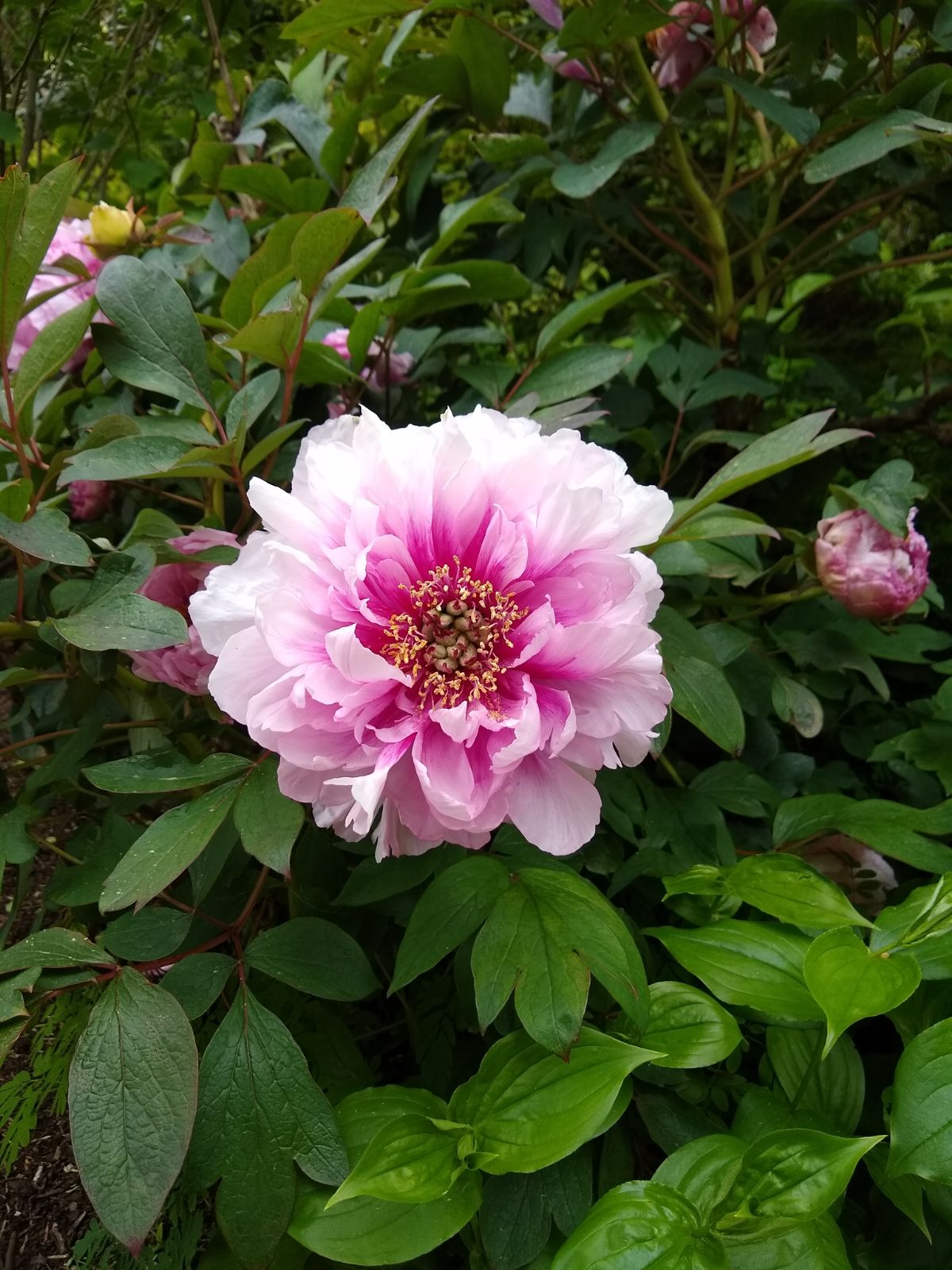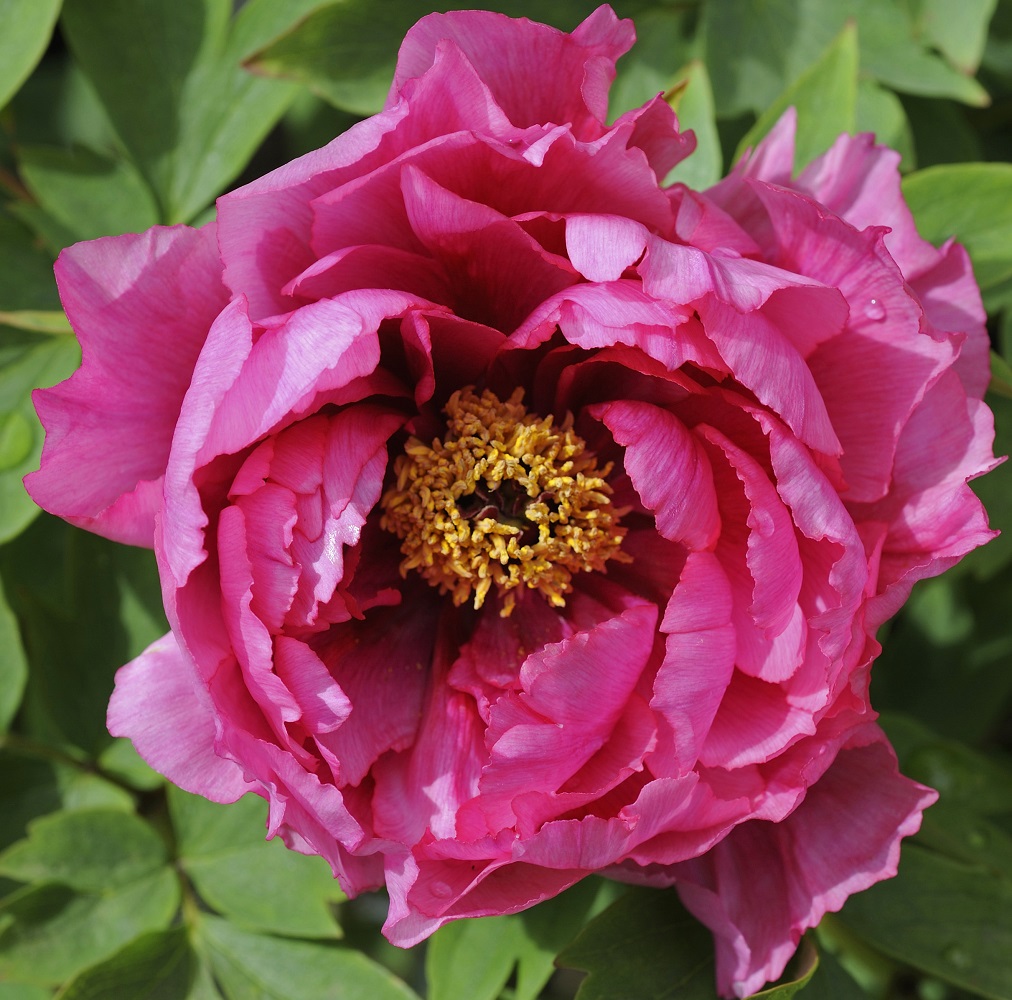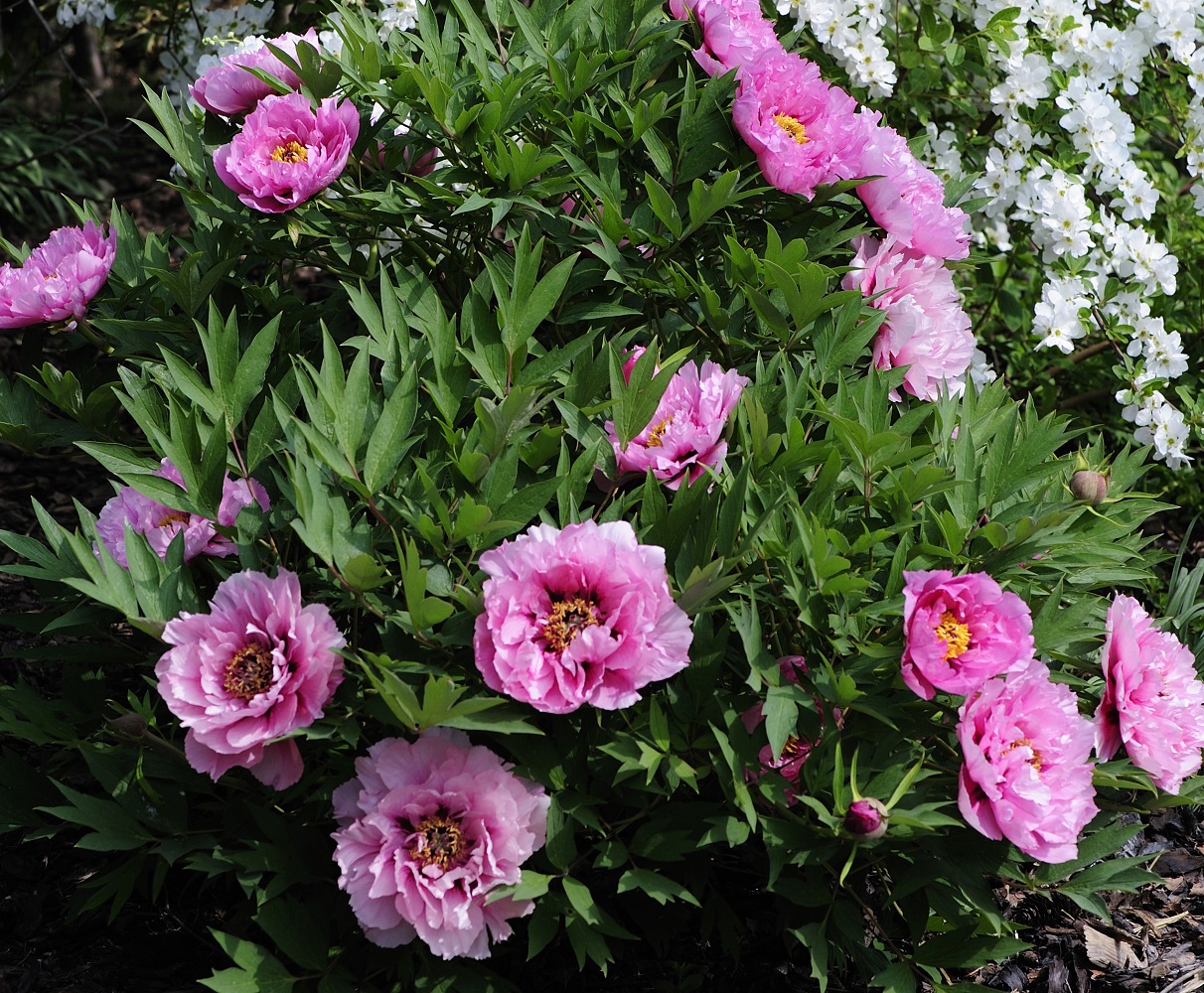Paeonia Central Plains Cultivars
Sponsor
Kindly sponsored by
Sponsored by David Sayers in memory of Hedvika Fraser.
Credits
Julian Sutton (2020)
Recommended citation
Sutton, J. (2020), 'Paeonia Central Plains Cultivars' from the website Trees and Shrubs Online (treesandshrubsonline.
Genus
Synonyms
- Paeonia Central Plains Group
- Paeonia Zhongyuan Group
Infraspecifics
Other taxa in genus
- Paeonia cathayana
- Paeonia decomposita
- Paeonia delavayi
- Paeonia Gansu Cultivars
- Paeonia Itoh Cultivars
- Paeonia Japanese Cultivars
- Paeonia jishanensis
- Paeonia × lemoinei
- Paeonia ludlowii
- Paeonia Lutea Hybrids
- Paeonia ostii
- Paeonia Other Shrubby Hybrids
- Paeonia qiui
- Paeonia rockii
- Paeonia rotundiloba
- Paeonia Southern Yangtze Cultivars
- Paeonia Southwest Cultivars
- Paeonia × suffruticosa
This is the largest and best known group of hybrid Chinese woody peonies, although not the best suited to most parts of our area. Usually shorter than Gansu cultivars, they are unlikely ever to exceed 1.8 m and for many 1 m is nearer the mark. Leaves are generally glabrous, with 9 rounded, lobed leaflets. Flowers are large, on relatively short pedicels, close to or even amongst the foliage and often tending to hang. Petal colour varies widely in the pink-red-purple area, or can be white, sometimes with a greenish or yellowish tint; some have red basal blotches but this is not the norm. Scent is faint compared with the Gansu cultivars, but usually pleasant. The disc sheathing the carpels is brown-red. Almost every type of flower form is known in this group (Wang 1998; McLewin & Chen 2006).
The Central Plains cultivars probably emerged as a distinct assemblage during the Tang Dynasty, 618–907 CE (Li 2005). Their primary area of cultivation has always been around the middle and lower reaches of the Yellow River; Heze (Shandong Province) and Luoyang (Henan) are particularly important centres (Wang 1998). The plants are adapted to this area’s continental climate: winters are dry and rather cold, spring is warm and dry, while summers are hot and humid with high rainfall. Central Plains varieties are now grown more widely in China, even in colder northern areas with winter protection (Wang 1998). Until very recently P. jishanensis was been considered the central wild parent of this group, with additional genetic input from P. rockii, P. qiui and P. ostii (Li 2005). However, molecular analysis of 47 cultivars suggests that the recently-described P. cathayana may be the single most important progenitor, with P. jishanensis relegated to the list of secondary wild ancestors (Zhou et al. 2014).
Central Plains cultivars have made important genetic contributions to the Southwest and Southern Yangtze hybrids, as well as being the progenitors of the Japanese cultivars (Cheng 2007). A few examples reached Europe in the late 18th century, sent by the Scottish surgeon John Duncan to Joseph Banks in 1787, with later importations by his brother Alexander Duncan (Bean 1976; Noltie 2017). The Duncans worked in the far south of China where Central Plains peonies will not survive for long; these would have been plants shipped south for a festival. More were sent from Shanghai in the 1840s by Robert Fortune, to the Horticultural Society of London and English nurserymen Standish & Noble. It should be noted that there is a blurred line between Central Plains varieties and the Southern Yangtze cultivars (q.v.) derived from them, which are grown in the Shanghai area. Some of these Fortune introductions were given European names and distributed in Europe, but have made little lasting contribution to Western gardens. Examples include ‘Banksii’ (Duncan, double, variously described as ‘lilac rose’ (Burkhardt 2020) and ‘purplish red at base, fading to almost white at the tips’ (Bean 1976)); ‘Bijou de Chusan’ (see below), ‘Glory of Shanghai’ (Fortune, double pink); ‘Robert Fortune’ (Fortune, double pink); ‘Zenobia’ (Fortune, red) – (Burkhardt 2020). A lilac-pink double, directly descended from a Duncan introduction, exists at RBG Edinburgh (Noltie 2017). European varieties descended from Central Plains and Japanese cultivars in the 19th century were numerous, but probably never very common in gardens; a few such as ‘Comtesse de Tuder’ survive at low levels – (Bean 1976).
Central Plains cultivars are grown on a field scale by nurseries in Shandong, mainly for the domestic market, but small numbers are exported to Europe and North America. Division and grafting onto herbaceous peony stocks are the usual means of propagation (Wang 1998; R. Scruton, pers. comm. 2020) although there is ongoing research on tissue culture (Cheng 2007). McLewin & Chen (2006) note that in Chinese nurseries plants which ‘look right’ are sometimes mixed with clonally propagated stocks, just as sometimes happens in Europe.
These varieties are widely considered difficult to grow well in Britain, and more widely in western Europe (Bean 1976; McLewin & Chen 2006; Austin 2020). Problems include buds breaking too early, poor flowering, susceptibility to peony blight (Botrytis paeoniae), poor root growth and general failure to thrive. Fertile, well-drained, loamy soil in a cool but not overhung position is a good starting point (Clarke 1988). Long-term pot culture does not seem to be a good alternative, unless the container is very large (R. Scruton, pers. comm. 2020). Nor are these plants widely suitable in North America; even the more continental central United States does not seem ideal, perhaps because winter temperatures fall too low or summer rainfall is too unreliable. Gansu cultivars are in general better suited to our area.
A small selection of cultivars gives some idea of their diversity; most of these are at least sometimes available outside China; unless otherwise stated they are old Chinese varieties. Cultivar information from Wang (1998), Tree Peony Company (2020), Burkhardt (2020).
'Bijou de Chusan'
Double flowers, white blushed light pink towards the petal bases, to 18 cm across. A Central Plains variety introduced to Europe by Robert Fortune in 1846, and renamed.
'Comtesse de Tuder'
Double, light salmon pink flowers to 18 cm across, tending to hang. Raised by Charles Gombault, France, 1856 (American Peony Society 2020).
'Dou Lu'
Double (crown or globular) flowers, pale green with purple basal stain, to 12 cm across; low, spreading branches; floriferous, late season. The name translates as ‘pea green’ or ‘green of beans’.
'Hei Hua Kui'
Semi-Double (Chrysanthemum form)) flowers, dark red, to 17 cm across; low, spreading branches; weakly growing but floriferous. The name translates as ‘black flower chief’ or ‘king of black flowers’.
'Hong Bao Shi'
Semi-Double (Rose form) flowers, crimson, to 16 cm across; medium height, vigorous. The name translates as ‘ruby’ or ‘red precious stone’.
'Huang Hua Kui'
Semi-Double (Lotus form) flowers, cream, to 14 cm across, held erect; tall and upright. The name translates as ‘yellow flower queen’.
'Lan Bao Shi'
Semi-Double (Chrysanthemum form flowers), usually with proliferation, lavender-pink with a purple flare, to 16 cm across, held upright; stiffly erect branches; floriferous and tolerant of intense sun. Bred by Team 9, Zhaolou, Heze, 1975. The name translates as ‘sapphire’.
'Pan Zhong Qu Guo'
Single flowers, light purple, to 12 cm across; medium height, vigorously growing. The name translates as ‘fruits plucked from bowl’.
'Yin Hong Qiao Dui'
Semi-Double (Rose, sometimes Chrysanthemum form) flowers, pink, flushed red towards the base, to 15 cm across; medium height, with stout branches; vigorous and adaptable. Bred by Zhaolou Peony Garden, Heze, 1966. The name translates as ‘silver and red perfectly matched’.
'Zhao Fen'
Flowers double (Globular) sometimes semi-double, pink, flushed redder at base, to 18 cm across; medium height, spreading branches; vigorous and floriferous. A widely known classic. The name translates as ‘Zhao’s pink’.
'Zhong Sheng Hong'
Double (Crown form) flowers with proliferation, red-flushed deep purple towards the base, to 14 cm across; short, with relatively few flowers. The name translates as ‘traditional red flower’.









